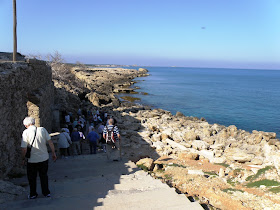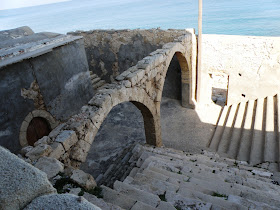 |
| Chapel built over spring at Apostolos Andreas Monastery |
The Monastery of Apostolos Andreas is situated overlooking the sea just south of Cape Zafer on the northeastern point of Cyprus. The monastery is dedicated to Saint Andrew (Apostle Andreas) who supposedly was the first person to be called for induction to priesthood by Jesus Christ. His title was O Protoklitos, meaning 'the one first called.'
 |
| Upper level at Apostolos Andreas Monastery |
This monastery ranks second only to the Monastery of St. Barnabas in popularity for religious pilgrims. It is considered one of the pilgrimage centers of the Cypriot Orthodox Church and was once known as the 'Lourdes of Cyprus.'
 |
| Monastery of Apostolos Andreas |
But this monastery was never really a true monastery. It was merely the parish church for the local inhabitants.
The buildings that comprise the whole were mostly built in the 1900s. Apostolos Andreas was and continues to be served not by an organized community of monks, but by a changing group of volunteer priests and laymen. Today a priest in Dipkarpaz drives to Apostolos Andreas to conduct mass for its inhabitants. This surprises me because I was not aware that any Orthodox priests remain in northern Cyprus. All the Orthodox churches we have seen on the north side have been abandoned, shuttered and/or vandalized. The monastery is looked after by a small community of Greeks who did not flee when the Turks took control of this side of the island after the war of 1974.
 |
| Spring at bottom; Apostolos Andreas Monastery |
On the site where tradition says St. Andrew came ashore and found water there is a small chapel built over the gushing spring. Like at St. Barnabas, both Greek and Turkish Cypriots come to take the waters. The alleged curative powers of these waters is such that bottles are taken to sick relatives across the globe in hopes that it will effect a cure.
 |
| Waters from spring |
 |
| One of many buildings at monastery |
The monastery complex is much larger than I had imagined. There are numerous large barracks-type buildings up the hillside from the monastery building itself, which is built somewhat over the chapel over the spring. These buildings were used to house the visitors that once came to make the annual pilgrimage.
The most popular times of pilgrimage were the period covering St. Andrew’s feast days of 15 August and 30 November. Since the opening of the borders, Greek Cypriots are able once again to freely visit one of their favorite pilgrimage sites. The weekends are particularly busy.
 |
| Note man bent so far over, Apostolos Andreas Monastery |
We visited on a Friday. While we were there a large tour bus arrived. But all appeared and sounded to be elderly British tourists. Did not see one single person who looked Greek.
In Byzantine times (284-642 A.D.) there was a fortified abbey on this site. It has long since completely disappeared. It is believed by some that this site, rather than Kantara Castle, is where the island of Cyprus was surrendered to Richard the Lionheart.
 |
| Wander anywhere you like |
 |
| Repairs underway |
We walked all over the monastery and the grounds and no one approached us to say any area was off-limits or to collect any type fees. In several places the old buildings were being held together by metal scaffolding while new mortar dried. They should collect a small 'donation' from each visitor to help toward this cause.
 |
| Round protrusion is an oven |
If one continues past Apostolos Andreas the paved (if you can call it paved these days) road ends and a dirt road continues onward. At the very eastern tip of the island there is a very large cave riddled rock. Nearby are the ruins of the Neolithic village of Kastros, which later was the site of yet another ancient temple to Aphrodite, situated at the very tip of the island.
 |
| Apostolos Andreas Monastery |
The small islands off the eastern tip of Cyprus are an important breeding site for rare birds such as the Shag and the Audouins Gull. A Shag is a form of cormorant. The Audouins Gull is a large gull which is found only in the Mediterranean and the western coast of Sahara Africa. In the late 1960s this was one of the world's rarest gulls, with a population of only 1,000 pairs. It has established new colonies, but remains rare with a population of about 10,000 pairs. Unlike many large gulls, Audouins gulls rarely scavenge. It is a specialist fish eater and strictly coastal and pelagic. This bird feeds slowly as night, well out to sea; and can sometimes be seen slowly patrolling close toward beaches..
The Karpaz area of Cyprus also remains home for many wild donkeys. The donkeys were used by farmers until the 1970s, when tractors and trucks fell more into favor. Donkeys were abandoned by their owners and were left to fend for themselves. Eventually, stray donkeys were rounded up and taken to the Karpaz, which is considered a wildlife refuge.

No comments:
Post a Comment
Your comment will be posted after we confirm that you are not a cyber stalker.